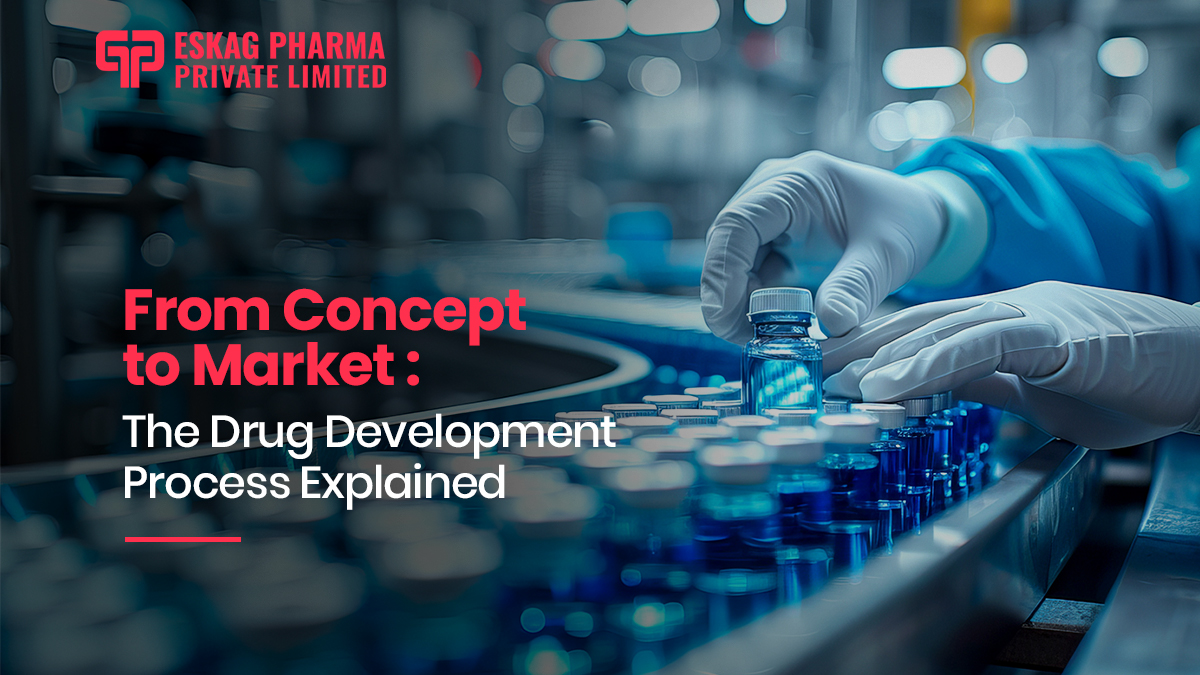From Concept to Market: The Drug Development Process Explained
The concept of drug development is the process of bringing a new drug to the market and consists of multiple stages starting with the discovery of the lead compound, followed by preclinical research (conducted in microorganisms and animals), clinical trials (in humans), and regulatory approval to market the drug.

It is a complex and rigorous process. The clinical development of a new drug is fraught with risk and uncertainty, with many human trials failing to achieve registration. Each phase is designed to assess the safety, efficacy, and dosage of the drug, ultimately leading to regulatory approval.
In this blog, we will take a closer look at the key stages of developing a drug along with different phases of drug development, the challenges involved, and the vital role played by regulatory authorities such as the FDA (U.S. Food and Drug Administration) and EMA (European Medicines Agency) in drug approvals.
Key Stages of Drug Development
1. Drug Discovery
Drug discovery is the process of identifying a compound therapeutically useful as a remedy and treating diseases. It involves identification, synthesis, characterisation, screening and assay for therapeutic efficacy.
2. Preclinical Research
Preclinical research is the laboratory tests of a new drug or medical device, usually done on animal subjects, to check the safety and efficacy of the newly discovered drug molecule.
The purpose of a preclinical study is to gather sufficient data on whether it is safe to proceed with further tests related to the drug. The main objective is to collect data to submit to the FDA to start the clinical trial for the newly developed drug by applying for investigational new drug application(IND).
3. Clinical Trials (Phase I-IV)
Clinical trials are research studies involving people (healthy volunteers or patients) that test the safety and efficacy of a new intervention/treatment.
The phases can be categorized as follows:
Phase I
- Also called First-in-Human Trials.
- It is the first stage of testing in humans.
- Around 20-25 healthy individuals are taken as subjects to assess the safety, tolerability, pharmacokinetics and pharmacodynamics of the drug.
- Duration can be around 6-12 months depending upon the drug tested.
- This phase aims to determine the maximum tolerated dose (MTD) of the drug.
- Phase 1 study acts as an interface between drug discovery and drug development.
Phase II
- Also called as Therapeutic exploratory trial.
- Around 20-300 human subjects participate in this phase.
Objectives of phase 2 are:
- Efficacy in patients
- Safety issues with the drug
- Therapeutic dose regimen
- Frequency of administration
Phase III
Also called as Therapeutic Confirmatory Trial
- It is a large-scale, multicentric, randomized controlled trial.
- Target population can be around 3,000.
- It usually takes up to 5 years to complete this phase of the trial.
- Objective is to assess overall and relative therapeutic value of the new drug’s efficacy, safety and special properties.
Phase IV
Also called Post-Marketing Surveillance (PMS) is done after the drug approval process by the regulatory authorities.
4. Regulatory Review
After successful completion of Phase III trials, the data is submitted to regulatory authorities for review. In the U.S., the FDA is responsible for approving new drugs, while the EMA oversees the approval process in Europe. These agencies rigorously review the clinical trial data to ensure that the drug is safe and effective for its intended use.
The review process includes evaluating the drug’s labeling, prescribing information, and manufacturing process to ensure that the drug is produced consistently and meets quality standards. If the regulatory body is satisfied with the evidence, it grants approval for the drug to be marketed and prescribed to patients.
5. Manufacturing Considerations: From Lab to Large Scale
Once a drug has received regulatory approval, the focus shifts to large-scale production adhering to the principles of Good Manufacturing Practices (GMP).
Manufacturers must ensure that the drug is produced with the same quality and purity as was demonstrated in clinical trials. Medicine manufacturers in India face strict regulatory oversight to ensure their products meet global standards.
Drug Development Challenges
- High costs: Bringing a new drug to market can cost billions of dollars, with no guarantee of success.
- Time-intensive process: It typically takes 10-15 years to develop a new drug from concept to market.
- Regulatory hurdles: Obtaining regulatory approval is a complex and lengthy process, with stringent requirements for safety and efficacy.
- Drug development failures: A significant percentage of drugs fail during clinical trials, especially in the later stages, where efficacy may not meet expectations or adverse effects emerge.
These challenges can be addressed by
- Enhanced collaboration: Foster partnerships between industry, and regulatory bodies to streamline research and share resources.
- Innovative technology: Use advanced technologies like AI and machine learning to optimise drug discovery and clinical trials.
- Regulatory flexibility: Work closely with regulatory authorities to adapt to evolving guidelines and expedite the approval process.
- Efficient manufacturing: Partner with third-party manufacturers to scale production while maintaining quality standards.
Conclusion
The drug development process is an intricate journey involving multiple phases that assess safety, efficacy, and dosage before reaching patients. Understanding this process highlights not only its complexity but also its importance in delivering safe and effective medications. Regulatory bodies like the FDA and EMA play an instrumental role in ensuring that only high-quality, effective drugs reach the market.
As India continues to grow as a hub for pharmaceutical innovation with medicine manufacturers in India, overcoming the challenges in drug development will be crucial for bringing new treatments to market efficiently.
